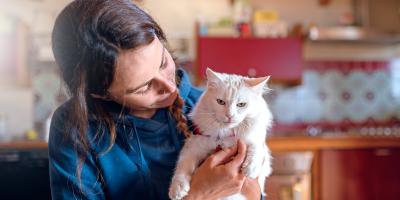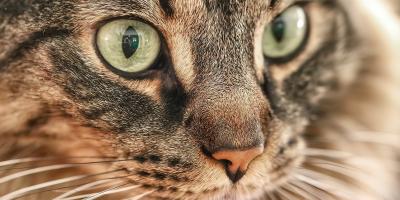
Dogs are known for expressing their feelings through their tails, but they’re not the only pets that do so. Cats also use their tails to tell you what they want — or don't — so learning how to interpret your cat's tail twitches, flicks and wags can help you better anticipate and meet her needs. So, what does it mean when a cat wags its tail? We answer that question and provide some insights into cat tail body language below.
Why Do Cats Wag Their Tails?
Cats wag their tails for many reasons, and deciphering what a wag could mean is going to depend heavily on the individual cat and her personality. Here are just a few of the things it can mean when your cat wags her tail.
She's Happy to See You
If your cat is wagging her tail and showing other positive, friendly body language such as alert, blinking eyes and ears that are pointed forward, she might just be happy to see you. Look for fanned-out whiskers, a head held upright and meowing or purring sounds.
She's Scared
Cats are known for being stoic, and they might not show fear directly. However, a wagging tail along with flattened ears, dilated pupils and flattened whiskers could indicate the cat is scared. If it's an unfamiliar cat, it's best to approach slowly or not at all to avoid frightening her more and risking an attack.
She Wants to Play
Cats can also wag their tails when they want to play. Key body language signs to look for here are a tail that is curled and ears that are pointed forward. She may also be showing her belly or rolling around on the ground to indicate that she wants you to interact with her.
She's Relaxed
Relaxed cats often wag their tails just as a natural movement when they are calm and peaceful. A relaxed cat will have a calm facial expression with the whiskers fanned out a bit. A cat that is hiding can also look similar to a relaxed, crouched pose, but the key thing to look for here is tension. A scared cat will be tense and ready to jump at any moment, whereas a relaxed cat is more fluid.
She Wants to Be Left Alone
A tail wag isn't always a good thing, and sometimes that back and forth could be a warning from your cat to stay away. Other negative body language cues to look for include flattened ears, dilated pupils, the hair on her back being raised and any kind of hissing or growling noises.
Common Cat Tail Movements and What They Mean
As we see above, looking for other body language signs to help you interpret what your cat's tail wagging means is helpful, but you can also look at the type of tail movement to get some clues. Here are a few common cat tail movements and what they might mean for your cat.
The Low Flick
If your cat's tail is low and flicking back and forth quickly, this is a sign that she needs some space. Cats usually display this behaviour when they are not happy.
The Low Wag
A low tail that is slowly wagging back and forth is an indication that the cat may be frightened. A low tail in general is a sign that things aren't going well for your cat, and a wag can turn into the flick that is mentioned above if you don't take the cue to back off.
The Slow Swish
If your cat is slowly swishing her tail from side to side, even if it's not in the low position, this could indicate that she is annoyed. You might see this when you're late for feeding time or when you aren't giving her the attention she wants.
The Quick Swish
A tail that is quickly swishing from side to side is indicative of a playful cat. The main difference between this and the low flick above that indicates an angry cat is the position of the tail. The quick swish usually appears with a high tail and is often seen when your cat is playing with you or other cats or getting ready to pounce on a toy.
The Quick Twitch
Another cat tail movement associated with pouncing and hunting behaviours is the quick twitch. This is a short movement that happens right at the end of the cat's tail and is something you would likely see when your cat is looking at birds out the window or stalking a toy.
The Quiver
If your cat comes up to you with her tail held high and the tip quivering like a rattlesnake, good news! Your cat is happy to see you. You may see this kind of tail movement when you come home from work or first thing in the morning when your cat sees you.
The Wrap
Sometimes, you may notice your cat wrapping her tail around your hand or neck. This is a sign of affection and can be a way to ask for physical contact, similar to your cat head-butting you to get you to pet her.
The Fluff
When your cat is scared or anxious, you may see her fluff up her tail. This is a way to make her look bigger to other cats, other animals and possible predators and scare them away from a possible attack.
The Sleep Twitch
When your cat is sleeping, you may notice her twitch her tail if you talk to her or go over to pet her. She twitches her tail to acknowledge your presence and say "Hi" as she continues sleeping.
The Lying-Down Wave
Sometimes cat tail wagging may indicate that your cat is in pain or feeling unwell. A sign that your cat isn't feeling her best is if you see her lying down and wagging her tail. If there are other signs, such as the cat hiding more than usual or not eating, it may be time for a vet visit.
Learn more about how to best care for your cat and interpret cat behaviour in our pet care archives.
Related articles



